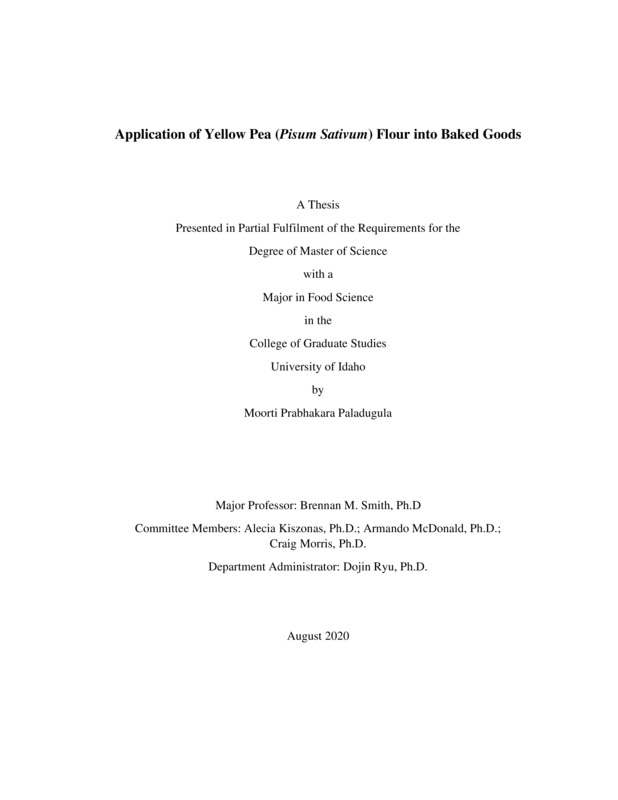APPLICATION OF YELLOW PEA (PISUM SATIVUM) FLOUR INTO BAKED GOODS
Paladugula, Moorti Prabhakara. (2020-08). APPLICATION OF YELLOW PEA (PISUM SATIVUM) FLOUR INTO BAKED GOODS. Theses and Dissertations Collection, University of Idaho Library Digital Collections. https://www.lib.uidaho.edu/digital/etd/items/paladugula_idaho_0089n_11897.html
- Title:
- APPLICATION OF YELLOW PEA (PISUM SATIVUM) FLOUR INTO BAKED GOODS
- Author:
- Paladugula, Moorti Prabhakara
- ORCID:
- https://orcid.org/0000-0002-0629-2791
- Date:
- 2020-08
- Embargo Remove Date:
- 2021-02-26
- Keywords:
- Baked goods Descriptive sensory panel Physical attributes Pulse Sensory attributes Yellow pea flour
- Program:
- Food Science
- Subject Category:
- Food science
- Abstract:
-
Legumes and pulses are increasingly viewed as a superfood and sustainable future protein source. Yellow pea flour produced in large quantities in North America is high in protein and fiber, and low in lipids. The objective of this thesis is to study the effect of incorporating dry split yellow pea flour into baked goods like bread and pancakes and identify the threshold of maximum incorporation at which physical and sensorial attributes are not affected significantly.
The section titled “the physical and sensorial characterization of yellow split pea flour incorporated pancakes” in the thesis tested the effect of pea flour addition on pancake physical and sensorial properties by instrumental analyzes and a trained descriptive panel at levels of 1%, 2%, 5%, 10%, and 20% w/w basis. Sodium metabisulfite (SMB) was added as the reducing agent to evaluate the hypothesis that changes to protein conformation will impact the flavor profile of the pea flour. All the pancake batters prepared with pea flour, with pea flour and SMB, and with only SMB were optimized to have the same viscosity. It was observed that viscosity optimization was advantageous in attaining pancakes with similar physical attributes, like height, weight, and diameter. There were no significant differences in the measure of weight, height, and specific volume of pancake amongst all the treatments with the value of control at 244.73 g, 2.22 cm3/g, and 4.97 cm, respectively. However, the deviation was not avoidable at a higher level of pea flour incorporation (i.e., 20%) for diameter and texture, which ranged from 12.18 to 13.13 cm and 2637.52 to 3316.86 g, respectively. Sensory attributes did not show any drastic improvement with the addition of SMB. Nevertheless, some interesting observations on the overall sensorial attributes of pancakes were made.
The “Incorporation of yellow pea flour into white pan bread” section of this thesis investigates the bread quality of pea flour incorporated bread. Pea flour was added at 1%, 2%, 5%, 10%, and 20% levels, and the resulting bread was evaluated for the physical and sensory quality. For sensory analysis, control (100% wheat flour), 5%, and 20% of bread were made and evaluated by a consumer panel. It was observed that the bread made with 10% pea flour was not significantly different from control in terms of height, specific volume, and firmness. Bread incorporated with 5% and 20% pea flour was not perceived to be different by the consumer panel. However, the control was significantly different for flavor, after-taste, willingness to buy, and overall acceptability from the pea flour incorporated treatments. On the other hand, control was similar to 10% pea flour bread in terms of texture and appearance. The panelists were not able to differentiate between the appearance of the bread across all treatments.
- Description:
- masters, M.S., Food Science -- University of Idaho - College of Graduate Studies, 2020-08
- Major Professor:
- Smith, Brennan M
- Committee:
- McDonald, Armando; Morris, Craig; Kiszonas, Alecia
- Defense Date:
- 2020-08
- Identifier:
- Paladugula_idaho_0089N_11897
- Type:
- Text
- Format Original:
- Format:
- application/pdf
- Rights:
- In Copyright - Educational Use Permitted. For more information, please contact University of Idaho Library Special Collections and Archives Department at libspec@uidaho.edu.
- Standardized Rights:
- http://rightsstatements.org/vocab/InC-EDU/1.0/

